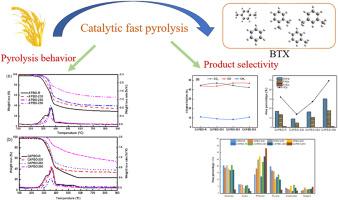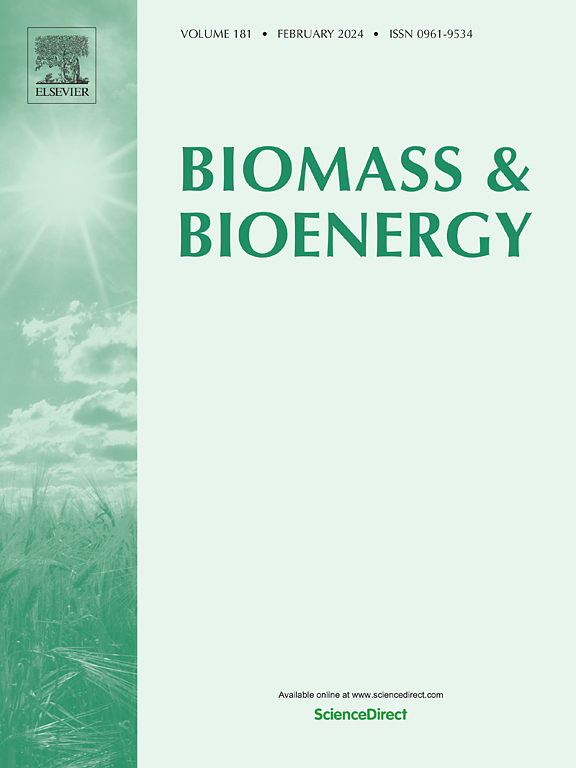酸洗和热解对生物质热解特性和产品分布的影响
IF 5.8
2区 生物学
Q1 AGRICULTURAL ENGINEERING
引用次数: 0
摘要
本研究探讨了一种新的耦合预处理方法,即水相生物油(APBO)酸洗和热解耦合预处理,旨在提高小麦秸秆催化快速热解(CFP)过程中生物油的质量并改善碳氢化合物的选择性。实验结果表明,与醋酸相比,APBO 能更有效地去除 AAEMs,对 K 的去除率高达 98.77%。而另一方面,腐熟会降低 O 含量和 O/C 分子摩尔比。热重分析(TGA)结果表明,耦合预处理方法提高了样品的最大损耗率,表明促进了纤维素和半纤维素的热解。耦合预处理使热解生物油中的酸和酮减少,糖和酚增加。在耦合预处理后加入 HZSM-5 催化剂,碳氢化合物的产量显著提高,碳氢化合物的产量从原始样品的 28.06% 提高到耦合预处理样品的 49.5%。这种耦合预处理方法为在生物质 CFP 过程中实现高质量和选择性生物油转化提供了一种新方法。本文章由计算机程序翻译,如有差异,请以英文原文为准。

Impact of acid washing and torrefaction on biomass pyrolysis characteristics and product distribution
This work examined a new coupled pretreatment method was investigated, namely, coupled pretreatment by aqueous phase bio-oil (APBO) acid washing and torrefaction, aimed at enhancing the quality of bio-oil and improving hydrocarbon selectivity during catalytic fast pyrolysis (CFP) of wheat straw. The experimental results showed that APBO was more effective in removing AAEMs compared to acetic acid, the removal of K was as high as 98.77 %. Torrefaction, on the other hand, decreases the O content and the O/C molecular molar ratio. Thermogravimetry analysis (TGA) results showed that the coupled pretreatment method raised the maximum loss rate of the samples suggesting the promotion of cellulose and hemicellulose pyrolysis. Coupled pretreatment resulted in a decrease in acids and ketones and an increase in sugars and phenols in the pyrolyzed bio-oil. Upon adding the HZSM-5 catalyst after the coupled pretreatment, hydrocarbon production was significantly enhanced, leading to an increase in hydrocarbon yield from 28.06 % in the original sample to 49.5 % in the coupled pretreated sample. This coupled pretreatment method presents a novel approach for achieving high-quality and selective bio-oil conversion during CFP of biomass.
求助全文
通过发布文献求助,成功后即可免费获取论文全文。
去求助
来源期刊

Biomass & Bioenergy
工程技术-能源与燃料
CiteScore
11.50
自引率
3.30%
发文量
258
审稿时长
60 days
期刊介绍:
Biomass & Bioenergy is an international journal publishing original research papers and short communications, review articles and case studies on biological resources, chemical and biological processes, and biomass products for new renewable sources of energy and materials.
The scope of the journal extends to the environmental, management and economic aspects of biomass and bioenergy.
Key areas covered by the journal:
• Biomass: sources, energy crop production processes, genetic improvements, composition. Please note that research on these biomass subjects must be linked directly to bioenergy generation.
• Biological Residues: residues/rests from agricultural production, forestry and plantations (palm, sugar etc), processing industries, and municipal sources (MSW). Papers on the use of biomass residues through innovative processes/technological novelty and/or consideration of feedstock/system sustainability (or unsustainability) are welcomed. However waste treatment processes and pollution control or mitigation which are only tangentially related to bioenergy are not in the scope of the journal, as they are more suited to publications in the environmental arena. Papers that describe conventional waste streams (ie well described in existing literature) that do not empirically address ''new'' added value from the process are not suitable for submission to the journal.
• Bioenergy Processes: fermentations, thermochemical conversions, liquid and gaseous fuels, and petrochemical substitutes
• Bioenergy Utilization: direct combustion, gasification, electricity production, chemical processes, and by-product remediation
• Biomass and the Environment: carbon cycle, the net energy efficiency of bioenergy systems, assessment of sustainability, and biodiversity issues.
 求助内容:
求助内容: 应助结果提醒方式:
应助结果提醒方式:


